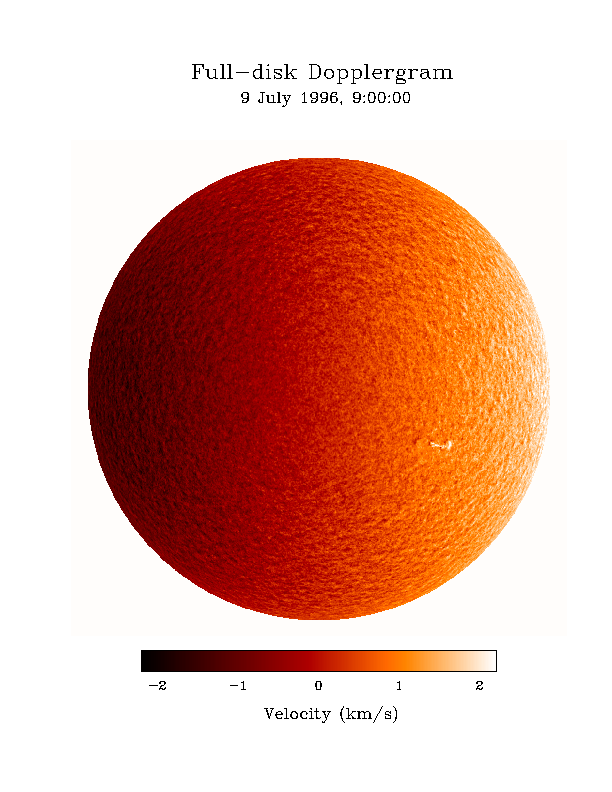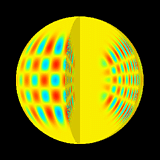5. SOLAR OSCILLATIONS
The discrepancy between theory and observation of solar neutrinos noted above makes us worry that we don't understand the Sun's interior structure as well as we think. That raises the stakes in finding a new way to measure the density and temperature inside the Sun. And, just in time, scientists have found a method to do that with unprecedented accuracy. This method is called
helioseismology. It is the study of the natural vibrations of the Sun through observations of motions of the photosphere. (Remember, we measure motions through the Doppler shifts of spectral lines.)
The word helioseismology is a combination of helios, the Greek word for Sun, seismos, which means tremors, and ology, which means "study of". It is the solar analogy of seismology, the study of the Earth's tremors. By measuring the vibrations at the Earth's surface following an earthquake, seismologists can infer the interior structure of the Earth. The same principle holds for the Sun, so it's a logical name.
In the early 1960s, scientists began to observe the motions of the Sun's photosphere by measuring the Doppler shifts of spectral lines. The figure below shows a snapshot of these motions, or, better yet, you can look at this
movie. They saw that the Sun was covered with cells that seemed to be bobbing up and down with a period of about 5 minutes. They measured the frequencies of these oscillations more and more accurately, and found that the Sun was virtually ringing like a bell. Like a musical instrument, it didn't oscillate at just one frequency, but at many precise frequencies, called resonances. The oscillations seen at the surface have their roots in the Sun's interior. The frequencies of the Sun's oscillations are sensitive to the sound speed inside the Sun, which depends on temperature and composition. The higher the temperature inside the Sun, the higher the frequencies of the oscillations; the higher the ratio of helium to hydrogen abundance, the lower the frequencies.
|

|
|
A Dopplergram of the Sun's surface. The dark areas are moving toward us and the light areas are moving away from us. The left hemisphere is darker because it is moving toward us (negative velocities) and the right hemisphere is lighter because it is moving away from us (positive velocities). In addition to this global pattern, caused by the Sun's rotation, we see a pattern of small cells bobbing up and down, due to oscillating sound waves in the Sun's interior. From the Stanford Solar Center. |
Each different resonance (natural oscillation frequency) of the Sun corresponds to a different pattern, called a mode, of waves, as illustrated below. A wave that involves motion of a few large patches of surface penetrates deeper into the Sun's interior and has a slightly lower resonance frequency than waves that involve motions of many small patches of surface. By comparing the resonance frequencies of the deeper waves with those of the shallower waves, we can see how the sound speed varies with depth beneath the Sun's surface. For a thorough explanation of these principles, with plenty of graphics, see
Helio- and Asteroseismology from Aarhus University (Denmark).
|

|

|
|
As waves propagate through the Sun's interior, they set up oscillating patterns on its photosphere that we can observe to infer its interior structure. |
One particular mode of solar oscillation. The blue patches are rising while the red patches are descending. From the Stanford Solar Center. |
The more accurately we can measure the frequencies of the Sun's oscillations, the more accurately we measure the properties of the Sun's interior. To measure these frequencies accurately, we want to count the number of up and down motions at the Sun's surface over a long time. It's like taking a person's pulse -- if you count the pulses for a minute or two, you will get a much more accurate reading than if you do it for 10 seconds. Likewise, you don't want gaps in your record. Counting pulses for 15 seconds at a time, four separate times, is not as accurate as counting pulses without interruption for a solid minute.
We have a problem counting pulses from the Sun's surface for a long time: the Sun sets every day! That means, with one telescope on the ground, we can't measure the Sun's oscillations for much longer than 12 hours without the interruption of night. There are two ways to get around this problem. One is to build a network of telescopes around the Earth all designed to observe the Sun's oscillations. (Midnight in Colorado is noon in India.) By gathering together the data from all the telescopes, we can count the oscillations without interruption for many days. A consortium of scientists, supported by several nations, has built just such a network, called the Global Oscillations Network Group, or
GONG.
The other way is to watch the Sun's oscillations from a spacecraft, and an international consortium of scientists has built just such a spacecraft, called the Solar and Heliospheric Observatory, or
SOHO. Besides carrying an instrument specifically designed to measure the Sun's oscillations (see Solar Oscillations Investigation), SOHO carries many other instruments designed to measure ultraviolet and optical radiation from the Sun's upper atmosphere and corona and atomic particles in the Sun's wind, as we describe in section 6.
Both GONG and SOHO have delivered: now we can measure the sound speed deep in the Sun's interior to an accuracy of better than 0.1%. The results verify that the theoretical models for the Sun's interior temperature and composition are correct. We must seek another explanation to account for the discrepancy between the predicted and observed fluxes of solar neutrinos.
In addition to measuring the Sun's internal density and temperature, the GONG and SOHO observations enable us to measure the rotation speed of the Sun's interior. A few years ago, many scientists speculated that the interior of the Sun might be rotating faster than the outside. But the new observations from GONG and SOHO now rule out that possibility. But just a few months ago, scientists discovered "rivers" flowing beneath the surface of the Sun from SOHO data. You can find an excellent description of SOHO observations and discoveries in the
Stanford Solar Center.
(Return to course home page)
Last modified September 16, 2000
Copyright by Richard McCray


